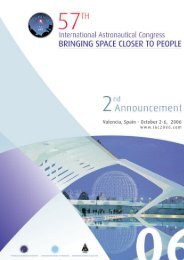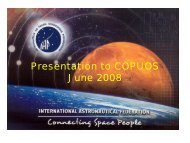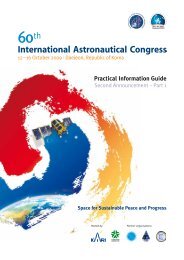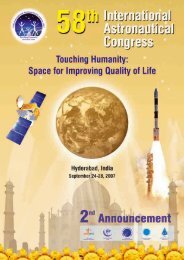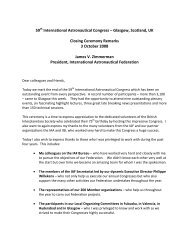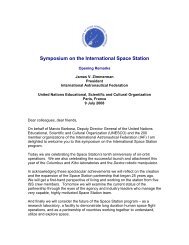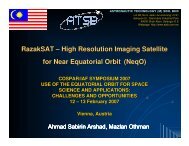Developing an Equatorial Earth Observation Satellite System
Developing an Equatorial Earth Observation Satellite System
Developing an Equatorial Earth Observation Satellite System
You also want an ePaper? Increase the reach of your titles
YUMPU automatically turns print PDFs into web optimized ePapers that Google loves.
National Institute of Aeronautics <strong>an</strong>d Space – LAPAN<br />
Indonesia<br />
<strong>Developing</strong> <strong>an</strong> <strong>Equatorial</strong> <strong>Earth</strong> <strong>Observation</strong> <strong>Satellite</strong> <strong>System</strong><br />
Toto Marn<strong>an</strong>to Kadri<br />
National Institute of Aeronautics <strong>an</strong>d Space – LAPAN<br />
Indonesia<br />
presented at<br />
COSPAR/IAF Symposium<br />
at the Forty-Fourth Session<br />
of the Scientific <strong>an</strong>d Technical Subcommittee<br />
of the Committee on the Peaceful Uses of Outer Space<br />
in Vienna, Austria<br />
Use of the <strong>Equatorial</strong> Orbit for Space Science <strong>an</strong>d Applications:<br />
Challenges <strong>an</strong>d Opportunities<br />
12-23 February 2007
National Institute of Aeronautics <strong>an</strong>d Space – LAPAN<br />
Indonesia<br />
<strong>Developing</strong> <strong>an</strong> <strong>Equatorial</strong> <strong>Earth</strong> <strong>Observation</strong> <strong>Satellite</strong> <strong>System</strong><br />
Introduction: <strong>Equatorial</strong> <strong>an</strong>d Near-<strong>Equatorial</strong> Orbit <strong>Earth</strong> <strong>Observation</strong> satellites.<br />
• <strong>Equatorial</strong> orbit having a zero degree inclination in the earth’s equatorial pl<strong>an</strong>e;<br />
• According to altitude above earth surface, satellite orbits are distinguished<br />
between Low <strong>Earth</strong> Orbit (LEO, 200-1,200 km), Medium <strong>Earth</strong> Orbit (MEO, 1,000-<br />
3,600 km) <strong>an</strong>d Highly Eliptical Orbit (HEO, 50,000-400,000 km);<br />
• Focusing on the use of equatorial MEO <strong>an</strong>d near-equatorial LEO satellites;<br />
• Technical requirements <strong>an</strong>d considerations of equatorial <strong>an</strong>d near-equatorial<br />
<strong>Earth</strong> <strong>Observation</strong> (EO) satellites;<br />
• Utilization <strong>an</strong>d application of equatorial <strong>an</strong>d near-equatorial orbiting EO satellites;<br />
• Challenges <strong>an</strong>d opportunities on development of equatorial <strong>an</strong>d near-equatorial<br />
orbiting EO satellites.
National Institute of Aeronautics <strong>an</strong>d Space – LAPAN<br />
Indonesia<br />
<strong>Developing</strong> <strong>an</strong> <strong>Equatorial</strong> <strong>Earth</strong> <strong>Observation</strong> <strong>Satellite</strong> <strong>System</strong><br />
Need of space applications in Indonesia:<br />
Extensive <strong>an</strong>d diverse geography of Indonesia;<br />
Growing need of space technology utilization <strong>an</strong>d application for national<br />
development:<br />
+ Telecommunication (first domestic satellite telecommunication system in<br />
operation in 1976);<br />
+ <strong>Earth</strong> observation (natural resources, rural <strong>an</strong>d infrastructure development,<br />
l<strong>an</strong>d use, environment, weather, climate <strong>an</strong>d others);<br />
+ Navigation;<br />
+ Disaster mitigation <strong>an</strong>d relief;<br />
+ Health;<br />
+ Education;<br />
+ Others;<br />
Requirement on utilization of progressive space technology <strong>an</strong>d application for<br />
sustainable development;
National Institute of Aeronautics <strong>an</strong>d Space – LAPAN<br />
Indonesia<br />
<strong>Developing</strong> <strong>an</strong> <strong>Equatorial</strong> <strong>Earth</strong> <strong>Observation</strong> <strong>Satellite</strong> <strong>System</strong><br />
Import<strong>an</strong>ce of equatorial satellite orbit for Indonesia:<br />
Indonesia is located roughly 5,150 km along the length of the equator (or about<br />
1/8 th of the length) , <strong>an</strong>d the widest breadth is roughly 1,750 km.<br />
Equator<br />
The unique equatorial location of maritime continent Indonesia (marine, coastal<br />
<strong>an</strong>d l<strong>an</strong>d environment) provide geographical adv<strong>an</strong>tages for utilization of satellites<br />
in the equatorial <strong>an</strong>d near-equatorial inclination orbits, e.g. earth observation,<br />
communication, disaster m<strong>an</strong>agement <strong>an</strong>d others.
National Institute of Aeronautics <strong>an</strong>d Space – LAPAN<br />
Indonesia<br />
<strong>Developing</strong> <strong>an</strong> <strong>Equatorial</strong> <strong>Earth</strong> <strong>Observation</strong> <strong>Satellite</strong> <strong>System</strong><br />
Approximate optimum coverage of equatorial <strong>an</strong>d near equatorial satellite orbit<br />
inclination over Indonesia for <strong>Earth</strong> <strong>Observation</strong> (EO) satellites.<br />
Latitude 10 0 N<br />
i = 0 0<br />
Near-equatorial LEO require at least two EO satellites<br />
at 10 0 orbit inclination.<br />
Latitude 10 0 S
National Institute of Aeronautics <strong>an</strong>d Space – LAPAN<br />
Indonesia<br />
<strong>Developing</strong> <strong>an</strong> <strong>Equatorial</strong> <strong>Earth</strong> <strong>Observation</strong> <strong>Satellite</strong> <strong>System</strong><br />
Coverage of one satellite in near-equatorial LEO at 10 0 inclination over Indonesia.<br />
Approx. 5 0 ground station<br />
<strong>an</strong>tenna elevation,<br />
h ~ 650 km.<br />
Biak<br />
Parepare<br />
Rumpin
National Institute of Aeronautics <strong>an</strong>d Space – LAPAN<br />
Indonesia<br />
<strong>Developing</strong> <strong>an</strong> <strong>Equatorial</strong> <strong>Earth</strong> <strong>Observation</strong> <strong>Satellite</strong> <strong>System</strong><br />
World coverage of one satellite in near-equatorial LEO at 10 0 inclination, h ~ 650 km.
National Institute of Aeronautics <strong>an</strong>d Space – LAPAN<br />
Indonesia<br />
<strong>Developing</strong> <strong>an</strong> <strong>Equatorial</strong> <strong>Earth</strong> <strong>Observation</strong> <strong>Satellite</strong> <strong>System</strong><br />
Topical <strong>Earth</strong> Resources <strong>Satellite</strong><br />
- TERS Study.<br />
Joint study by Nederl<strong>an</strong>ds Institut Voor<br />
Vliegtuigontwikkeling En Ruimtevaart – NIVR<br />
<strong>an</strong>d LAPAN during 1979 to 1986.<br />
With respect to orbit coverage repetition cycles<br />
preference is for one equatorial 0 0 inclination<br />
MEO satellite at 1,680 km altitude. Off-nadir<br />
pointing coverage over orbit path between 10 0 N<br />
<strong>an</strong>d 10 0 S. True equatorial orbit provide 11 orbit<br />
passes per day, with available 4 passes in<br />
daylight between 07:30 <strong>an</strong>d 16:30 used for data<br />
acquisition. Spacecraft mass is about 950 kg.<br />
Selective remote sensing of primary sensor offnadir<br />
viewing is assisted by the forward viewing<br />
cloud sensor.<br />
An alternative is two identical satellites at 847<br />
km altitude LEO in complementing 10 0 - 15 0<br />
near-equatorial inclination. Off-nadir pointing<br />
capability is used.
National Institute of Aeronautics <strong>an</strong>d Space – LAPAN<br />
Indonesia<br />
<strong>Developing</strong> <strong>an</strong> <strong>Equatorial</strong> <strong>Earth</strong> <strong>Observation</strong> <strong>Satellite</strong> <strong>System</strong><br />
Tropical <strong>Earth</strong> Resources <strong>Satellite</strong><br />
- TERS Study.<br />
Mission requirement is compared to<br />
existing <strong>an</strong>d future LEO (polar orbit) remote<br />
sensing satellite systems of that period.<br />
Imaging spectral characteristics:<br />
TERS 1: 490 - 590 nm<br />
TERS 2: 610 - 685 nm<br />
TERS 3: 750 - 835 nm<br />
TERS PAN: 490 - 685 nm<br />
Ground resolution 16x16 m multispectral<br />
<strong>an</strong>d 8x8 m p<strong>an</strong>chromatic. Swath is 60 km.<br />
Value added processed L<strong>an</strong>dsat-7 ETM map,<br />
acquired <strong>an</strong>d processed by Pusdata, LAPAN.<br />
Shrimp farming, Lampung Province, Indonesia<br />
Fields of (higher repetition) application:<br />
• Resource base mapping;<br />
• Agriculture <strong>an</strong>d forestry;<br />
• Tr<strong>an</strong>smigration;<br />
• Rural <strong>an</strong>d urb<strong>an</strong> survey;<br />
• Public works;<br />
• Environment protection;<br />
• Oce<strong>an</strong>ography.
National Institute of Aeronautics <strong>an</strong>d Space – LAPAN<br />
Indonesia<br />
<strong>Developing</strong> <strong>an</strong> <strong>Equatorial</strong> <strong>Earth</strong> <strong>Observation</strong> <strong>Satellite</strong> <strong>System</strong><br />
<strong>Satellite</strong> technology opportunity:<br />
Micro-<strong>Satellite</strong>s < 100 kg.<br />
Use of current adv<strong>an</strong>ced technology;<br />
Opportunities for international cooperation;<br />
Access to knowledge, skill <strong>an</strong>d experience;<br />
Carry experimental <strong>an</strong>d demonstration<br />
mission payloads;<br />
Ease of satellite development:<br />
+ Simplified production <strong>an</strong>d test facility;<br />
+ Shorter development time;<br />
+ Lower costs;<br />
Indonesi<strong>an</strong> engineers with LAPAN-TUBSAT micro-satellite<br />
developed by LAPAN in cooperation with Technische<br />
Universität Berlin, Germ<strong>an</strong>y, <strong>an</strong>d launched as auxilliary<br />
payload on Indi<strong>an</strong> Space Research Org<strong>an</strong>ization (ISRO)<br />
PSLV-C7 Cartosat-2 <strong>an</strong>d SRE mission on 10 J<strong>an</strong>uary 2007.<br />
Possible launch to orbit as <strong>an</strong> auxilliary<br />
payload on launch vehicle;<br />
Used by governments, private comp<strong>an</strong>ies<br />
<strong>an</strong>d universities for experimental application<br />
<strong>an</strong>d technology demonstration satellites.
National Institute of Aeronautics <strong>an</strong>d Space – LAPAN<br />
Indonesia<br />
<strong>Developing</strong> <strong>an</strong> <strong>Equatorial</strong> <strong>Earth</strong> <strong>Observation</strong> <strong>Satellite</strong> <strong>System</strong><br />
LAPAN-TUBSAT micro-satellite.<br />
Tr<strong>an</strong>sfer of knowledge, skill <strong>an</strong>d experience on<br />
micro-satellite technology development from<br />
Technische Universität Berlin, Germ<strong>an</strong>y to LAPAN.<br />
Dimension approx 45 cm (l) x 45 cm (w) x 27 cm (h)<br />
Weight 54.7 kg.<br />
Interactive 3-axis attitude control;<br />
Star Sensor for satellite attitude determination;<br />
CCD color video camera on 1,000 mm Cassegrain<br />
lens provide 5 m ground resolution <strong>an</strong>d 3.5 km swath;<br />
CCD color video camera on 50 mm lens provide<br />
81 km swath <strong>an</strong>d 200 m resolution;<br />
Provide space borne EO surveill<strong>an</strong>ce for, e.g. natural<br />
resources, environment <strong>an</strong>d disaster m<strong>an</strong>agement;<br />
Polar LEO orbit at 630 km altitude, inclination at 97,6 0 .<br />
Launched as auxilliary payload on ISRO PSLV-C7<br />
Cartosat-2 <strong>an</strong>d SRE mission at SDSC SHAR, India, on<br />
10 J<strong>an</strong>uary 2007.
National Institute of Aeronautics <strong>an</strong>d Space – LAPAN<br />
Indonesia<br />
<strong>Developing</strong> <strong>an</strong> <strong>Equatorial</strong> <strong>Earth</strong> <strong>Observation</strong> <strong>Satellite</strong> <strong>System</strong><br />
LAPAN investigation of satellite EO mission requirement (imaging <strong>an</strong>d surveill<strong>an</strong>ce):<br />
Food security application, e.g.<br />
• Crop yield estimation;<br />
• Crop growth cycle;<br />
• Marine food resource;<br />
• Agriculture l<strong>an</strong>d use <strong>an</strong>d estates;<br />
• Estimation of pl<strong>an</strong>ting season;<br />
• Soil <strong>an</strong>d agroclimate,<br />
<strong>an</strong>d others.<br />
L<strong>an</strong>d application, e.g.<br />
• Disaster m<strong>an</strong>agement, e.g. l<strong>an</strong>d slide,<br />
volc<strong>an</strong>o, tsunami, floods, forest fires;<br />
• Natural resources m<strong>an</strong>agement;<br />
• Forest m<strong>an</strong>agement <strong>an</strong>d inventory;<br />
• L<strong>an</strong>d use <strong>an</strong>d l<strong>an</strong>d cover monitoring;<br />
• Environment monitoring, draught <strong>an</strong>d<br />
ch<strong>an</strong>ge detection;<br />
• Water catchment areas <strong>an</strong>d hydrology;<br />
• Geology, <strong>an</strong>d others.<br />
Marine application, e.g.<br />
• Coastal marine resources;<br />
• Potential fishing ground;<br />
• Coastal zone <strong>an</strong>d environment;<br />
• Marine pollution;<br />
• Marine vehicle monitoring;<br />
• River estuaries <strong>an</strong>d discharge,<br />
<strong>an</strong>d others.<br />
Technical requirements:<br />
LAPAN carry out study on technical<br />
requirements of micro-satellites for<br />
Indonesia in consultation with<br />
Germ<strong>an</strong> Aerospace Center (DLR).
National Institute of Aeronautics <strong>an</strong>d Space – LAPAN<br />
Indonesia<br />
<strong>Developing</strong> <strong>an</strong> <strong>Equatorial</strong> <strong>Earth</strong> <strong>Observation</strong> <strong>Satellite</strong> <strong>System</strong><br />
Immediate detection <strong>an</strong>d successive monitoring:<br />
Disaster m<strong>an</strong>agement:<br />
• Early warning;<br />
• Distress information;<br />
• Detection <strong>an</strong>d assessment of disaster areas;<br />
• Mitigation <strong>an</strong>d relief;<br />
• Rehabilitation.<br />
Recurring disasters:<br />
• <strong>Earth</strong>quake;<br />
• Tsunami;<br />
• Volc<strong>an</strong>ic eruption;<br />
• Floods <strong>an</strong>d flash floods;<br />
• L<strong>an</strong>d slides;<br />
• Draught <strong>an</strong>d climate <strong>an</strong>omalies;<br />
• Forest fires.<br />
Ulee Lhee, B<strong>an</strong>da Aceh, effects of Tsunami,<br />
Ikonos data.<br />
<strong>Equatorial</strong> <strong>an</strong>d near equatorial orbit EO <strong>an</strong>d data<br />
relay communication satellites are potential to<br />
provide immediate disaster relief information <strong>an</strong>d<br />
repetitive monitoring (multi-mission satellite).
National Institute of Aeronautics <strong>an</strong>d Space – LAPAN<br />
Indonesia<br />
<strong>Developing</strong> <strong>an</strong> <strong>Equatorial</strong> <strong>Earth</strong> <strong>Observation</strong> <strong>Satellite</strong> <strong>System</strong><br />
High spatial <strong>an</strong>d temporal resolution environment ch<strong>an</strong>ge detection <strong>an</strong>d monitoring:<br />
Vegetation Index map of rice fields in<br />
Karaw<strong>an</strong>g, West Java from MODIS data.<br />
• Agriculture (food production estimation, disease,<br />
pests, irrigation, agroclimate, perennial crop area);<br />
• Coastal <strong>an</strong>d marine resources;<br />
• Potential marine fishing ground;<br />
• Forestry (logging, illegal cutting, settlements,<br />
shifting cultivation, forest fire, l<strong>an</strong>d degradation,<br />
reforestation);<br />
• Urb<strong>an</strong> development <strong>an</strong>d l<strong>an</strong>d use ch<strong>an</strong>ge;<br />
• Marine pollution;<br />
• Coastal zone l<strong>an</strong>d use;<br />
• M<strong>an</strong>grove inventory;<br />
• Coral reef assessment;<br />
• Coastline ch<strong>an</strong>ge <strong>an</strong>d erosion;<br />
• Shipping traffic <strong>an</strong>d sea passage;<br />
• Water resources, <strong>an</strong>d others.<br />
<strong>Equatorial</strong> <strong>an</strong>d near equatorial EO satellites with<br />
high temporal resolution provide better access of<br />
detailed earth feature ch<strong>an</strong>ge monitoring.
National Institute of Aeronautics <strong>an</strong>d Space – LAPAN<br />
Indonesia<br />
<strong>Developing</strong> <strong>an</strong> <strong>Equatorial</strong> <strong>Earth</strong> <strong>Observation</strong> <strong>Satellite</strong> <strong>System</strong><br />
Opportunities for equatorial <strong>an</strong>d near-equatorial EO satellites:<br />
<strong>Equatorial</strong> <strong>an</strong>d near-equatorial EO satellite using selective off-nadir optical viewing<br />
assisted with cloud sensor provide opportunity as following:<br />
• High temporal resolution data acquisition of equatorial EO satellite (e.g. possible of up<br />
to 4 daylight passes for one TERS at 1,680 km MEO to cover 10 0 N <strong>an</strong>d 10 0 S latitude);<br />
• Optimized data acquisition of satellite passes to better serve user requirement;<br />
• Possible access of high spatial resolution data acquisition immediately required the<br />
same day <strong>an</strong>d successive observation for disaster monitoring, as well as other urgent<br />
special detection <strong>an</strong>d dynamic temporal monitoring purpose;<br />
• Possible programming <strong>an</strong>d selection of areas to be observed with acceptable cloud<br />
cover before <strong>an</strong>d during satellite data acquisition;<br />
• Better access of data acquisition for precise timely programmed monitoring of earth<br />
resource process <strong>an</strong>d environment process, e.g. crop yield estimation;<br />
• Multi-instrument payload increase the usefulness of equatorial <strong>an</strong>d near-equatorial EO<br />
satellite, e.g. data relay, space science <strong>an</strong>d others, e.g. multi-mission satellite;<br />
• Extended <strong>an</strong>d systematic high resolution EO data archiving of the equator region;<br />
• Interpretation of equatorial <strong>an</strong>d near-equatorial EO satellite data with variable<br />
illumination <strong>an</strong>d sun <strong>an</strong>gle could provide new detection <strong>an</strong>d application methods;<br />
• More benefit of near-equatorial orbit satellites for EO using imaging radar (SAR);<br />
• Data utilization <strong>an</strong>d benefit by countries located in the equator region.
National Institute of Aeronautics <strong>an</strong>d Space – LAPAN<br />
Indonesia<br />
<strong>Developing</strong> <strong>an</strong> <strong>Equatorial</strong> <strong>Earth</strong> <strong>Observation</strong> <strong>Satellite</strong> <strong>System</strong><br />
Challenges for equatorial <strong>an</strong>d near-equatorial EO satellites:<br />
• Effort to effectively use micro-satellites for near-equatorial EO experiments, e.g. with<br />
optical or thermal imagers, cloud cover sensor, off-nadir viewing, orbit mainten<strong>an</strong>ce;<br />
• Data acquisition at different time of daylight with varied illumination, sun <strong>an</strong>gle <strong>an</strong>d<br />
atmosphere scattering may be difficult for consistent interpretation methods, e.g. to<br />
achieve st<strong>an</strong>dard image quality for interpretation, as well as image data overlays;<br />
• Equator MEO EO satellites, e.g. TERS at 1,680 km <strong>an</strong>d 0 0 inclination orbit is exposed<br />
to higher radiation in space limiting effective operational lifetime. Radiation shielding<br />
will increase satellite weight;<br />
• Equator <strong>an</strong>d near-equator EO satellites will encounter more earth curvature <strong>an</strong>d<br />
atmosphere scattering at dist<strong>an</strong>t off-nadir viewing, i.e. limiting pointing <strong>an</strong>gles;<br />
• Use of LEO require a small constellation of near-equatorial orbit inclination EO<br />
satellites to achieve expected temporal resolution data acquisition of areas covering<br />
10 0 N <strong>an</strong>d 10 0 S latitude pointing <strong>an</strong>gles due to earth curvature <strong>an</strong>d atmosphere effects.<br />
This increase ground receiving stations operation, as well as incoming data volume;<br />
• Near-equator LEO EO satellites have complex arr<strong>an</strong>gement for image registration;<br />
• Higher revisit data acquisition require more operation of ground segment, user<br />
services, data processing, data archiving, cataloging <strong>an</strong>d acquisition priority setting;<br />
• More study is needed for new image data utilization <strong>an</strong>d application of equatorial<br />
<strong>an</strong>d near equatorial orbit EO satellites, <strong>an</strong>d to overcome its technical obstacles.
National Institute of Aeronautics <strong>an</strong>d Space – LAPAN<br />
Indonesia<br />
<strong>Developing</strong> <strong>an</strong> <strong>Equatorial</strong> <strong>Earth</strong> <strong>Observation</strong> <strong>Satellite</strong> <strong>System</strong><br />
Conclusion.<br />
• Indonesia shall potentially benefit from the use of equatorial <strong>an</strong>d near-equatorial<br />
orbit EO satellite utilization. Similar potential benefit could also be expected by<br />
other countries in the equatorial region;<br />
• High repetitive visit capability of equatorial <strong>an</strong>d near-equatorial orbit satellites,<br />
is potential for near real-time high resolution (possible daily) data acquisition <strong>an</strong>d<br />
dynamic temporal monitoring, e.g. for disaster m<strong>an</strong>agement <strong>an</strong>d others;<br />
• Forward viewing cloud sensor <strong>an</strong>d off-nadir main sensor payload viewing<br />
optimize the potential use of equatorial <strong>an</strong>d near-quatorial orbit EO satellites;<br />
• More study is needed to address mission requirement, data processing, data<br />
utilization, system operation <strong>an</strong>d technical design requirement;<br />
• Micro-satellites are potential experimental EO satellites in the near-equator<br />
inclined orbit, a.o. also to explore additional adv<strong>an</strong>tages <strong>an</strong>d challenges;<br />
• TERS Study shall be a signific<strong>an</strong>t baseline for work on equatorial <strong>an</strong>d nearequatorial<br />
orbit EO satellites in Indonesia;<br />
• LAPAN have consideration on the potential use of equatorial <strong>an</strong>d near-equatorial<br />
orbit EO satellites for Indonesia;<br />
• International cooperation is signific<strong>an</strong>t to elaborate <strong>an</strong>d utilize the optimum<br />
potential of equatorial <strong>an</strong>d near-equatorial EO systems, in particular countries to<br />
benefit from equatorial <strong>an</strong>d near-equatorial EO satellite orbit.
National Institute of Aeronautics <strong>an</strong>d Space – LAPAN<br />
Indonesia<br />
<strong>Developing</strong> <strong>an</strong> <strong>Equatorial</strong> <strong>Earth</strong> <strong>Observation</strong> <strong>Satellite</strong> <strong>System</strong><br />
References.<br />
Adi Sadewo Salatun, Space Technology Development <strong>an</strong>d Application in Indonesia, LAPAN, Asia<br />
Pacific Space Agency Forum-10 (APRSAF-10), JAXA-GISTDA, Chi<strong>an</strong>g Mai, 2004;<br />
Albert P. Hoeke <strong>an</strong>d P.F.J. Linsen, Workshpo Report: Workshop on the A-1 Study of a Joint<br />
Indonesi<strong>an</strong>-Netherl<strong>an</strong>ds Tropical <strong>Earth</strong> Resources <strong>Satellite</strong> (TERS) Program, NIVR-LAPAN,<br />
Delft, 1984;<br />
Documentation Section, PSLV Project, PSLV C7 Cartosat-2/SRE Mission, Indi<strong>an</strong> Space Research<br />
Org<strong>an</strong>ization, Triv<strong>an</strong>drum, 2007;<br />
N.J.J. Bunnik, R. v<strong>an</strong> Konijnenburg <strong>an</strong>d Mahsun Irsyam, User Requirements for a Tropical <strong>Earth</strong><br />
Resources <strong>Satellite</strong> (TERS) Sistem, NLR TR 84024 L, NIVR – LAPAN, Delft, 1984;<br />
S. Hardhienata, A. Nury<strong>an</strong>to, H. Triharj<strong>an</strong>to <strong>an</strong>d U. Renner, Technical Aspects <strong>an</strong>d Attitude Control<br />
Strategy of LAPAN-TUBSAT Micro-<strong>Satellite</strong>, LAPAN-Technische Universität Berlin,<br />
6 th International Symposium of the International Academy of Astronautics (IAA), Berlin, 2005;<br />
S. Hardhienata, Toto Marn<strong>an</strong>to Kadri <strong>an</strong>d K. Briess, Remote Sensing Micro-<strong>Satellite</strong> to Support Food<br />
Sustainability Program in Indonesia, LAPAN- Technische Universität Berlin, 10 th National<br />
Aerospace Science <strong>an</strong>d Technology Seminar (SIPTEKGAN – X), LAPAN, Serpong, 2006;<br />
Toto Marn<strong>an</strong>to Kadri, Space Science <strong>an</strong>d Technology Application at LAPAN, LAPAN, Asia Pacific<br />
Space Agency Forum-13 (APRSAF-13), JAXA-LAPAN, Jakarta, 2006.
National Institute of Aeronautics <strong>an</strong>d Space – LAPAN<br />
Indonesia<br />
<strong>Developing</strong> <strong>an</strong> <strong>Equatorial</strong> <strong>Earth</strong> <strong>Observation</strong> <strong>Satellite</strong> <strong>System</strong><br />
Judul.



